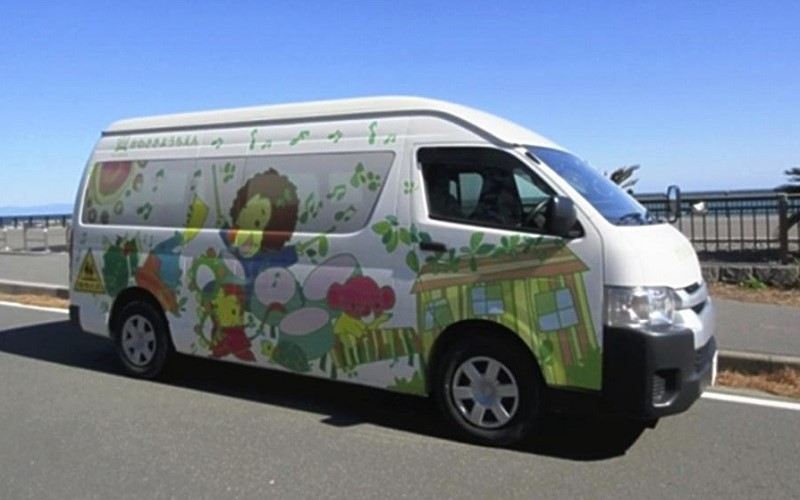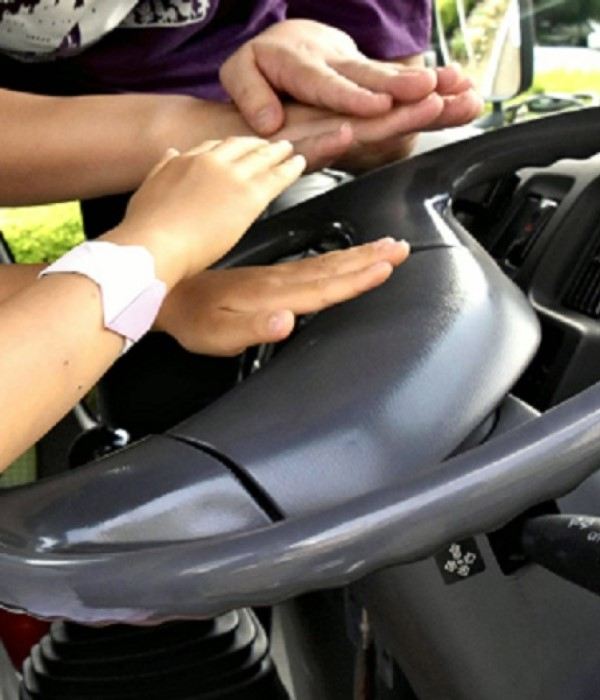
The school bus China Kawamoto was aboard
15:25 JST, September 13, 2022
A growing number of municipalities are implementing measures to protect the lives of small children, following the recent death from heatstroke of a 3-year-old girl who was left alone in a school bus at a childcare facility.
The central government has decided to conduct emergency inspections of nursery schools and other facilities around the country that use school buses, and plans to compile relevant emergency countermeasures in October. However, many municipalities are conducting exercises and field surveys on their own without waiting for the central government.

A kindergarten student practices honking a horn in Sayama, Saitama Prefecture, on Monday.
On Monday, the Musashino Junior College-affiliated kindergarten in Sayama, Saitama Prefecture, held a drill to deal with a possible situation in which children are left behind in a school bus. Aiming to enable children to seek help by themselves in case of emergency, the kindergarten had 42 children age 3 honk the horn in the driver’s seat.
Some children were scared of the loud noise, but the kindergarten staff and police officers from the Sayama police station gently taught them how to honk the horn.
“You can push the horn with your butt or a water bottle,” the children were told.
China Kawamoto, 3, died on Sept. 5 after being left alone in a locked school bus for about five hours at Kawasaki Yochien, a certified childcare facility that functions as both a nursery school and kindergarten, in Makinohara, Shizuoka Prefecture.
The bus was driven that day by Tatsuyoshi Masuda, 73, the board chairman of the facility, instead of the regular driver, who was off work. The facility said the incident had been caused by four mistakes: (1) not confirming that all of the children had gotten off the bus; (2) not having multiple staff members inspect inside afterward; (3) not conducting a final confirmation of the children’s attendance and (4) not confirming with the parents or guardians when a child who was supposed to be in attendance was not present.
The Shizuoka prefectural police are investigating the case on suspicion of professional negligence resulting in death. A similar incident occurred in July 2021, when a 5-year-old boy died after being left behind in a nursery school bus in Nakama, Fukuoka Prefecture.
The Fukushima prefectural government began sending survey sheets to all childcare facilities in the prefecture on Sept. 7, to check whether they confirm such matters as the number of children when getting on and off school buses and whether staff members share the information.
Similar surveys have been conducted in Miyagi and Gunma prefectures.
Iwate, Ibaraki, Chiba, Hiroshima and Miyazaki prefectures have also issued a notice asking relevant facilities to thoroughly confirm that no children are left behind in school buses.
No natl guidelines for school buses
According to the Cabinet Office and other sources, there are no safety guidelines compiled by the central government regarding the school bus services utilized by nursery schools and kindergartens, because such services do not fall under the category of childcare or educational activities.
Illustrations and other things are painted on the rear seat windows of the Kawasaki Yochien school bus where the girl was left alone, making it difficult to see in. However, the Land, Infrastructure, Transport and Tourism Ministry said there are no restrictions regarding painting school buses, except for the windshield and the driver and front passenger seat windows.
In South Korea, the issue of children being left behind on school buses came to be recognized as a social problem and in 2019, it became mandatory for school bus operators to install devices to check whether all passengers have disembarked. If a driver or other relevant person fails to press a release button installed at the back of a bus and perform certain other activities within three minutes after stopping the engine, an alarm near the driver’s seat goes off and emergency flashing lights are activated.
Since 2021, school bus operators have been required to check how transparent school bus windows are, to ensure that people outside the vehicle can see in.
Sanyo Trading Co., a Tokyo-based trading house dealing in interior materials for automobiles, is encouraging childcare and other facilities to introduce detection sensors in Japan that are used for school buses in the United States by the end of fiscal 2023. The sensors are made by IEE S.A., of Luxembourg, and are installed on the ceiling of a school bus. They send an alert when they detect passengers.
“We should not just condemn those responsible. We should closely examine why such a terrible incident occurred,” said Mafumi Usui, a professor of social psychology at Niigata Seiryo University.
"Society" POPULAR ARTICLE
-

M4.9 Earthquake Hits Tokyo, Neighboring Prefectures
-

Israeli Tourists Refused Accommodation at Hotel in Japan’s Nagano Pref., Prompting Protest by Israeli Embassy and Probe by Prefecture
-

M7.5 Earthquake Hits Northern Japan; Tsunami Waves Observed in Hokkaido, Aomori and Iwate Prefectures
-

Tsukiji Market Urges Tourists to Avoid Visiting in Year-End
-

M5.7 Earthquake Hits Japan’s Kumamoto Pref., Measuring Upper 5 Intensity, No Tsunami Expected
JN ACCESS RANKING
-

Tokyo Economic Security Forum to Hold Inaugural Meeting Amid Tense Global Environment
-

Keidanren Chairman Yoshinobu Tsutsui Visits Kashiwazaki-Kariwa Nuclear Power Plant; Inspects New Emergency Safety System
-

Imports of Rare Earths from China Facing Delays, May Be Caused by Deterioration of Japan-China Relations
-

University of Tokyo Professor Discusses Japanese Economic Security in Interview Ahead of Forum
-

Japan Pulls out of Vietnam Nuclear Project, Complicating Hanoi’s Power Plans






















